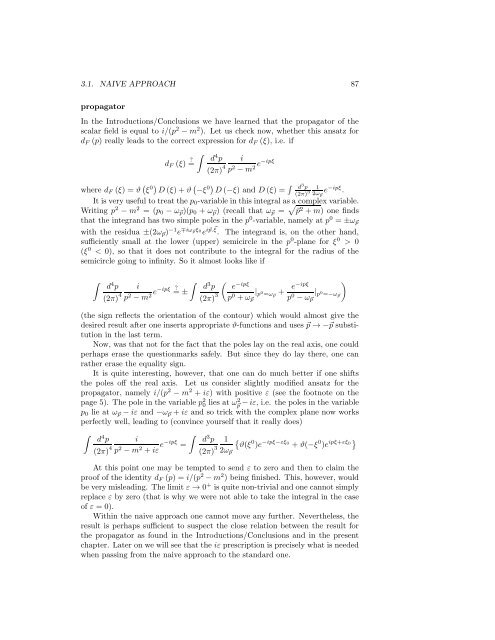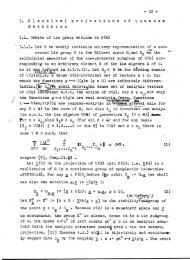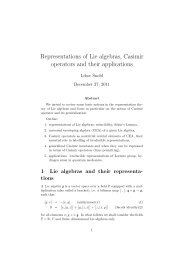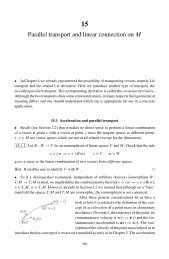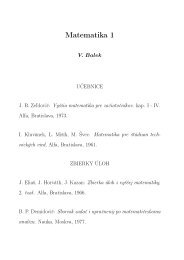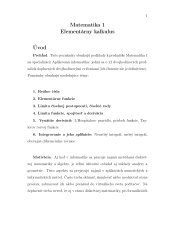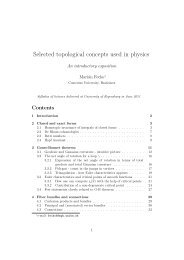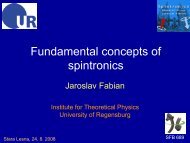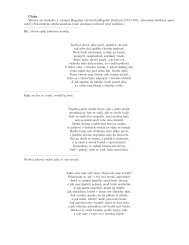Quantum Field Theory I
Quantum Field Theory I
Quantum Field Theory I
You also want an ePaper? Increase the reach of your titles
YUMPU automatically turns print PDFs into web optimized ePapers that Google loves.
3.1. NAIVE APPROACH 87<br />
propagator<br />
In the Introductions/Conclusions we have learned that the propagator of the<br />
scalar field is equal to i/(p 2 −m 2 ). Let us check now, whether this ansatz for<br />
d F (p) really leads to the correct expression for d F (ξ), i.e. if<br />
∫<br />
d F (ξ) =<br />
<br />
d 4 p i<br />
(2π) 4 p 2 −m 2e−ipξ<br />
where d F (ξ) = ϑ ( ξ 0) D(ξ)+ϑ ( −ξ 0) D(−ξ) and D(ξ) = ∫ d 3 p<br />
(2π) 3 1<br />
2ω ⃗p<br />
e −ipξ .<br />
It is very useful to treat the p 0 -variable in this integral asa complex variable.<br />
Writing p 2 − m 2 = (p 0 − ω ⃗p )(p 0 + ω ⃗p ) (recall that ω ⃗p = √ ⃗p 2 +m) one finds<br />
that the integrand has two simple poles in the p 0 -variable, namely at p 0 = ±ω ⃗p<br />
with the residua ±(2ω ⃗p ) −1 e ∓iω ⃗pξ 0<br />
e i⃗p.⃗ξ . The integrand is, on the other hand,<br />
sufficiently small at the lower (upper) semicircle in the p 0 -plane for ξ 0 > 0<br />
(ξ 0 < 0), so that it does not contribute to the integral for the radius of the<br />
semicircle going to infinity. So it almost looks like if<br />
∫<br />
d 4 ∫<br />
p i <br />
= ±<br />
(2π) 4 p 2 −m 2e−ipξ<br />
d 3 ( )<br />
p e<br />
−ipξ<br />
(2π) 3 p 0 | p<br />
+ω 0 =ω ⃗p<br />
+ e−ipξ<br />
⃗p p 0 | p<br />
−ω 0 =−ω ⃗p ⃗p<br />
(the sign reflects the orientation of the contour) which would almost give the<br />
desired result after one inserts appropriate ϑ-functions and uses ⃗p → −⃗p substitution<br />
in the last term.<br />
Now, was that not for the fact that the poles lay on the real axis, one could<br />
perhaps erase the questionmarks safely. But since they do lay there, one can<br />
rather erase the equality sign.<br />
It is quite interesting, however, that one can do much better if one shifts<br />
the poles off the real axis. Let us consider slightly modified ansatz for the<br />
propagator, namely i/(p 2 − m 2 + iε) with positive ε (see the footnote on the<br />
page 5). The pole in the variable p 2 0 lies at ω2 ⃗p<br />
−iε, i.e. the poles in the variable<br />
p 0 lie at ω ⃗p −iε and −ω ⃗p +iε and so trick with the complex plane now works<br />
perfectly well, leading to (convince yourself that it really does)<br />
∫<br />
d 4 ∫<br />
p i<br />
(2π) 4 p 2 −m 2 +iε e−ipξ =<br />
d 3 p 1 {<br />
ϑ(ξ 0<br />
(2π) 3 )e −ipξ−εξ0 +ϑ(−ξ 0 )e ipξ+εξ0}<br />
2ω ⃗p<br />
At this point one may be tempted to send ε to zero and then to claim the<br />
proof of the identity d F (p) = i/(p 2 −m 2 ) being finished. This, however, would<br />
be very misleading. The limit ε → 0 + is quite non-trivial and one cannot simply<br />
replace ε by zero (that is why we were not able to take the integral in the case<br />
of ε = 0).<br />
Within the naive approach one cannot move any further. Nevertheless, the<br />
result is perhaps sufficient to suspect the close relation between the result for<br />
the propagator as found in the Introductions/Conclusions and in the present<br />
chapter. Later on we will see that the iε prescription is precisely what is needed<br />
when passing from the naive approach to the standard one.


